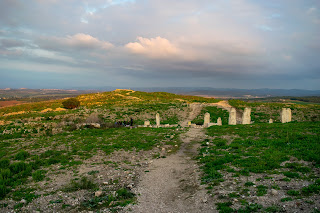What do you know about Tel Gezer?
Tel Gezer lies in central Israel, south of Tel Aviv and west of Jerusalem. A major biblical city that was conquered by Joshua (Joshua 10), given to the Levites, and fortified by Solomon in 1 Kings 9 after it was given to him as a wedding present from Pharaoh, its ruins date back to the Bronze Age and including civilizations like the Canaanites, Israelites, Assyrians, Babylonians, Persians, Greeks, and Romans.
There's so much here in this park that we're going to explore in 2 posts. First, the ruins!
We first come to the Canaanite tower, which is close to the city gates. What's interesting here is how far down the archeologists had to dig just to get to it! Can you see the contrast from the tower remains to the height of the wall directly behind it?
Above is the remains of the tower.
Next to it is the water system. I was going to go down there and then I heard that one was in fact full of bats- more than 1 million!- and my tour guide said: "Remember, 1 million bats = a lot of poop." I said, "That's okay, I'll take a picture of the entrance, haha."
From there, you go around to the Canaanite Gate:
But, can you see the mud bricks that still remain? How cool is that?
From here, you go up the hill and can see the ancient Solomonic-era city, complete with its city gates—the same ones that match Megiddo and Hazor!
The views to the valley beyond are beautiful. On the opposite hill you can see the caves mentioned where the kings of the conquered cities were buried in Joshua.
The 6-chambered Solomonic Gate!
In these photos, you can see the walls of the city are actually double-walls, with a chamber between them. It reminded me of
Masada, where the families of the warriors were right there in the room with them.
What was cool about this part were the families picnicking near the ruins. Children were exploring, walking around the walls and jumping between rocks. It's so mind-boggling to see ancient and modern side-by-side, and such a picture of how time moves on.
That's it for part 1 of Tel Gezer. Next week's post is about the most powerful part of the visit for me. See you then!







































































